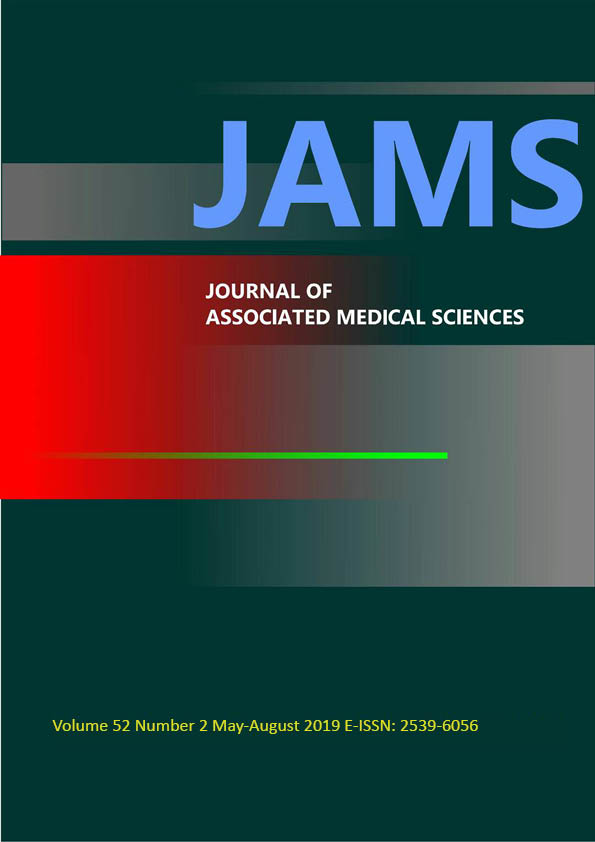Influence of short-term iodinated radiographic contrast media exposure on reactive oxygen species levels in K562 cancer cells
Main Article Content
Abstract
Background: Iodinated radiographic contrast media (IRCM) are commonly used for evaluating cancer diseases in diagnostic radiology. There are several studies that have showed the effects of IRCMs on various biological endpoints in normal cells. However, the effects of IRCMs on cancer cells is still a bit of a mystery.
Objectives: To investigate the effects of short-term iodinated radiographic contrast media exposure on reactive oxygen species levels in K562 cancer cells.
Materials and methods: Five commercially available IRCMs used were iohexol, iopamidol, iobitridol, ioxaglate, and iodixanol. A trypan blue exclusion assay was performed to evaluate the cytotoxicity of each IRCMs on K562 cancer cells. The effect of IRCMs on cell proliferation was further determined by counting the number of cells in metaphase. The reactive oxygen species (ROS) levels was determined at short-term by the use of a spectrofluorometric method.
Results: All IRCMs decreased in percentage of cell viability, number of metaphase cells, and levels of ROS in a concentration-dependent manner.
Conclusion: This study suggested that all IRCMs showed a short-term effect on K562 cancer cells by decreasing ROS levels in a concentration-dependent manner. In addition, IRCMs exhibited effect on cell viability and cell proliferation as well.
Article Details

This work is licensed under a Creative Commons Attribution-NonCommercial-NoDerivatives 4.0 International License.
Personal views expressed by the contributors in their articles are not necessarily those of the Journal of Associated Medical Sciences, Faculty of Associated Medical Sciences, Chiang Mai University.
References
[2] Andreucci M, Solomon R, Tasanarong A. Side effects of radiographic contrast media: pathogenesis, risk factors, and prevention. Biomed Res Int. 2014; 2014: 741018.
[3] Thomson KR, Varma DK. Safe use of radiographic contrast media. Aust Prescr. 2010; 33: 4.
[4] Lee SY, Jang YH, Lee MY, Hwang J, Lee SH, Chon MK, et al. The effect of radiographic contrast media on reperfusion injury in the isolated rat heart. Korean Circ J. 2014; 44(6): 423-8.
[5] Kerl JM, Nguyen SA, Lazarchick J, Powell JW, Oswald MW, Alvi F, et al. Iodinated contrast media: effect of osmolarity and injection temperature on erythrocyte morphology in vitro. Acta Radiol. 2008; 49(3): 337-43.
[6] Cetin M, Devrim E, Serin Kilicoglu S, Erguder IB, Namuslu M, Cetin R, et al. Ionic high-osmolar contrast medium causes oxidant stress in kidney tissue: partial protective role of ascorbic acid. Ren Fail. 2008; 30(5): 567-72.
[7] Galtung HK, Loken M, Sakariassen KS. Effect of radiologic contrast media on cell volume regulation in rabbit proximal renal tubules. Acad Radiol. 2001; 8(5): 398-404.
[8] Galtung HK, Sorlundsengen V, Sakariassen KS, Benestad HB. Effect of radiologic contrast media on cell volume regulatory mechanisms in human red blood cells. Acad Radiol. 2002; 9(8): 878-85.
[9] Feinendegen LE, Pollycove M, Sondhaus CA. Responses to low doses of ionizing radiation in biological systems. Nonlinearity Biol Toxicol Med. 2004; 2(3): 143-71.
[10] Spitz DR, Azzam EI, Li JJ, Gius D. Metabolic oxidation/reduction reactions and cellular responses to ionizing radiation: a unifying concept in stress response biology. Cancer Metastasis Rev. 2004; 23(3-4): 311-22.
[11] Smith JT, Willey NJ, Hancock JT. Low dose ionizing radiation produces too few reactive oxygen species to directly affect antioxidant concentrations in cells. Biol Lett. 2012; 8(4): 594-7.
[12] Tungjai M, Phathakanon N, Rithidech KN. Effects of Medical Diagnostic Low-dose X Rays on Human Lymphocytes: Mitochondrial Membrane Potential, Apoptosis and Cell Cycle. Health Phys. 2017; 112(5): 458-64.
[13] Naziroglu M, Yoldas N, Uzgur EN, Kayan M. Role of contrast media on oxidative stress, Ca(2+) signaling and apoptosis in kidney. J Membr Biol. 2013; 246(2): 91-100.
[14] Persson PB, Tepel M. Contrast medium-induced nephropathy: the pathophysiology. Kidney Int Suppl. 2006(100): S8-10.
[15] Loetchutinat C, Kothan S, Dechsupa S, Meesungnoen J, Jay-Gerin J-P, Mankhetkorn S. Spectrofluorometric determination of intracellular levels of reactive oxygen species in drug-sensitive and drug-resistant cancer cells using the 2′,7′-dichlorofluorescein diacetate assay. Radiation Physics and Chemistry. 2005; 72(2): 323-31.
[16] Bakris GL, Lass N, Gaber AO, Jones JD, Burnett JC, Jr. Radiocontrast medium-induced declines in renal function: a role for oxygen free radicals. Am J Physiol. 1990; 258(1 Pt 2): F115-20.
[17] Tungjai M, Sukantamala S, Malasaem P, Dechsupa N, Kothan S. An evaluation of the antioxidant properties of iodinated radiographic contrast media: An in vitro study. Toxicol Rep. 2018;5:840-5.
[18] Berg K, Skarra S, Bruvold M, Brurok H, Karlsson JO, Jynge P. Iodinated radiographic contrast media possess antioxidant properties in vitro. Acta Radiol. 2005; 46(8): 815-22.
[19] Xiong XL, Jia RH, Yang DP, Ding GH. Irbesartan attenuates contrast media-induced NRK-52E cells apoptosis. Pharmacol Res. 2006; 54(4): 253-60.
[20] Zager RA, Johnson AC, Hanson SY. Radiographic contrast media-induced tubular injury: evaluation of oxidant stress and plasma membrane integrity. Kidney Int. 2003; 64(1): 128-39.
[21] Kim KH, Park JY, Park HS, Kuh SU, Chin DK, Kim KS, et al. Which iodinated contrast media is the least cytotoxic to human disc cells? Spine J. 2015; 15(5): 1021-7.
[22] Andersen KJ, Christensen EI, Vik H. Effects of iodinated x-ray contrast media on renal epithelial cells in culture. Invest Radiol. 1994; 29(11): 955-62.
[23] Sendeski MM. Pathophysiology of renal tissue damage by iodinated contrast media. Clin Exp Pharmacol Physiol. 2011; 38(5): 292-9.
[24] Dascalu A, Peer A. Effects of radiologic contrast media on human endothelial and kidney cell lines: intracellular pH and cytotoxicity. Acad Radiol. 1994; 1(2): 145-50.
[25] Ribeiro L, de Assuncao e Silva F, Kurihara RS, Schor N, Mieko E, Higa S. Evaluation of the nitric oxide production in rat renal artery smooth muscle cells culture exposed to radiocontrast agents. Kidney Int. 2004; 65(2): 589-96.
[26] Potier M, Lagroye I, Lakhdar B, Cambar J, Idee JM. Comparative cytotoxicity of low- and high-osmolar contrast media to human fibroblasts and rat mesangial cells in culture. Invest Radiol. 1997; 32(10): 621-6.
[27] Fanning NF, Manning BJ, Buckley J, Redmond HP. Iodinated contrast media induce neutrophil apoptosis through a mitochondrial and caspase mediated pathway. Br J Radiol. 2002; 75(899): 861-73.

